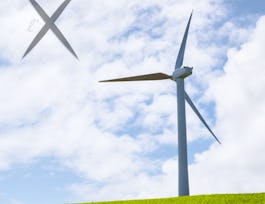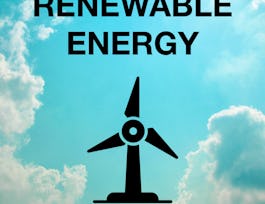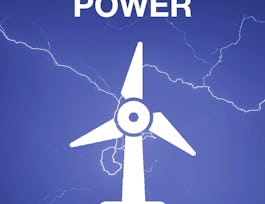Welcome to the course of Wind Energy. This course gives an overview of key aspects in wind energy engineering. Whether you are looking for general insight in this green technology or your ambition is to pursue a career in wind energy engineering, 'Wind Energy' is an excellent starting point.



(7,186 reviews)
Skills you'll gain
- Engineering Calculations
- Structural Analysis
- Structural Engineering
- Industrial Engineering
- Architectural Engineering
- Finite Element Methods
- Civil Engineering
- Civil and Architectural Engineering
- Electrical Engineering
- Systems Engineering
- Mechanical Engineering
- Process Engineering
- Building Services Engineering
- Architecture and Construction
- Drafting and Engineering Design
- Project Finance
- Forecasting
- Engineering
- Failure Analysis
- Engineering Analysis
Details to know

Add to your LinkedIn profile
17 assignments
See how employees at top companies are mastering in-demand skills


Earn a career certificate
Add this credential to your LinkedIn profile, resume, or CV
Share it on social media and in your performance review

There are 16 modules in this course
Xiaoli Guo Larsén gives a brief overview of the course, including its overall learning objectives, course structure, course content, the teachers, and the Coursera forum for interactions. You will also see the recommended prerequisites for following the course and find out how to earn points towards your course certificate.
What's included
1 video5 readings1 assignment1 discussion prompt
Lena Kitzing will teach you about financial aspects during the entire lifetime of a wind turbine. When you have completed the module, you will be able to perform simple calculations for assessing wind farm projects and for calculating the cost of energy from wind.
What's included
1 video2 readings2 assignments1 discussion prompt
Jake Badger will explain why assessing wind conditions is important and how features in the landscape affect wind conditions at different scales. You will learn about the Global Wind Atlas and how it can be used to identify flow effects and explore wind climates and resources. Wind atlas validation and data download will also be presented
What's included
2 videos1 reading1 assignment1 discussion prompt
Wind farm design optimization is a key step in overall wind farm project development. Developers need to side what turbines to use, where to place them, and how to design the rest of the system (balance of system including electrical collection system, turbine foundations, and more). This module introduces systems engineering for wind energy applications where holistic optimization methods are used for designing wind farms with the best possible performance at the lowest possible cost – in other words, to achieve a low cost of energy.
What's included
2 videos1 reading1 assignment1 discussion prompt
Gregor Giebel presents an overview of wind power forecasting, especially the motivation, the typical data flow, some error sources, and some specialised models for other uses than trading bulk power day-ahead. Forecasting wind (and similarly, solar) power in a system with 30% or more of renewables is paramount, and has been used operatively for 30 years. The uncertainty of the weather forecast can be quantified using ensembles, and the error sources depend on the type of forecast. Gregor Giebel in the second video gives an overview of the typical users of forecasts, of the ways to evaluate forecasts which depend (and should depend) highly on the use case, and presents the IEA Wind Recommended Practice for the Implementation of Renewable Energy Forecasting Solutions, which also is used in the test.
What's included
2 videos1 reading1 assignment1 discussion prompt
Mike Courtney tells how and why we perform wind measurements in Wind Energy, including main parameters that are necessary to measure, different instruments and their technologies and functions.
What's included
2 videos1 reading1 assignment1 discussion prompt
Mikael Sjöholm takes you on a tour to the technology landscape of remote sensing for wind energy starting in part 1 with the basic principles of remote sensing of one wind component using Radar, Lidar, and Sodar. He then continues by describing the differences between pulsed and continuous-wave devices before reaching part 2, where the basic principles for remote sensing of several wind components are reached and some tasters of use-cases for remote sensing in the domain of wind energy are served.
What's included
2 videos1 reading1 assignment1 discussion prompt
Kenneth Thomsen: Why and how to measure loads on wind turbines? Watch the video and learn the background and the methods!
What's included
1 video1 assignment1 discussion prompt
In this lecture Prof. Jens N. Sørensen presents a derivation of the Betz limit, which gives the theoretical upper limit for the power production of a horizontal axis wind turbine. The derivation is based on 1D momentum theory and shows that no more than 59.3% of the available power in the wind can be exploited in the rotor of a wind turbine.
What's included
1 video1 reading1 assignment1 discussion prompt
In part-1 video, Mac Gaunaa derives models for the ideal power production of simple drag- and lift-driven wind energy extraction devices from first principles analysis. These models reveal the key characteristics of the two different ways of extracting energy from wind, and is used to show which parameters influence the power, and what type of devices have the greatest power production potential per device area. In part-2 video , Mac Gaunaa uses the same set of key elements to explain the main operation principle for four different wind extraction devices: (1) Horizontal axis wind turbine, (2)Vertical axis giromill wind turbine, (3)Vertical axis drag turbine, (4)Ground generation crosswind kite.
What's included
2 videos1 reading1 assignment1 discussion prompt
Lars P. Mikkelsen demonstrates, in the first part of the lecture on composite materials for wind energy, how composite materials are used in wind turbine blades. Non-crimp glass fiber composites and pultruded carbon fiber composites will be introduced and the dominating loads working in a turbine blade will be shown. The second part of the lecture on composite materials for wind energy will show how to predict the stiffness of a composite from the properties of the constituents (fiber and matrix). During this, a big difference between the material stiffness in the fiber direction and transverse to the fiber direction is demonstrated. In the third and last part of the lecture on composite materials for wind energy, a procedure for testing and predicting the lifetime of composite materials is given. This will be used to predict the number of load cycles a composite material is expected to survive when loaded at a certain load-level or reversed which load level is allowed if a certain number of load cycles is required.
What's included
3 videos1 assignment1 discussion prompt1 ungraded lab
Martin Alexander Eder will in Part 1 teach Fatigue Phenomenon. High cycle fatigue is to date among the most frequent root causes for structural failure in wind turbines which need to endure billions of load cycles during their lifespan. Join me in this video to learn more about the fascinating phenomenon - high cycle fatigue - in wind turbine materials. Let us take an excursion starting at the nanostructure of different materials to observe where fatigue originates and how it evolves by zooming out across the characteristic length scales from micro to macro. This video provides an overview of the fundamental inner workings of the high cycle fatigue phenomenon and the differences observed in metallic materials such as steel and fibre-polymer composite materials, both of which being prominently represented in modern wind turbines. The observations made in this video are the steppingstone for understanding the process of fatigue life predictions presented in the second video – Fatigue life prediction. In part 2, he teaches Fatigue life prediction. It is recommended to watch the first video before embarking on watching fatigue life prediction to connect observation with application. In this video we take the observations made previously and learn how to apply them to make meaningful quantitative predictions of the fatigue life of steels as well as fiber-polymer composite materials. The focus of this video is put on the uniaxial SN-approach as the best-established method in industry. Light is shed on the experimental procedures involved to generate SN-curves and how they are used to generate constant life diagrams.
What's included
2 videos1 reading1 assignment1 discussion prompt
Xiao Chen introduces structural testing of rotor blades and their subcomponents using state-of-the-art experimental methods including measurements and inspection. In addition, this lecture introduces advanced finite element modeling to predict structural failure and damage where both simulation accuracy and efficiency are highlighted.
What's included
1 video1 assignment1 discussion prompt
Phillip Haselbach: The lecture intends on introducing you to the design and manufacturing of wind turbine blade structures. In the lecture Blade Design and Manufacturing you will learn how a typical design procedure of a wind turbine blade structure looks. During the lecture, the iterative design process from the idea to the final product is demonstrated. Moreover, the lecture focusses on the manufacturing process, where the different steps from the design of the moulds to the layup, vacuum infusion process and curing procedure will be explained as well as the final assembly of a wind turbine blade is illustrated.
What's included
1 video1 assignment1 discussion prompt
Cathy Suo provides introduction to VSC (voltage source converter) technology of HVDC (high voltage direct current) and its application in offshore wind energy
What's included
1 video1 assignment1 discussion prompt
Hjörtur Jóhannsson in the first lecture tells about frequency in electric power systems and how it is controlled. This answers questions: i) what causes system frequency to change? Ii) how to ensure a stable frequency? Iii) how do fluctuations in active power impact the system frequency? In the second lecture he explains the impact that short-term fluctuations in wind speed have on power system frequency. This includes explanations of the role the inertia of the individual wind turbines (WTs) has in reducing the impact of wind fluctuations and explanations of the effect of having numerous WTs in a wind farm in reducing the impact of wind fluctuations in the active power output the wind farm.
What's included
2 videos1 reading1 assignment1 discussion prompt
Instructors



Offered by
Why people choose Coursera for their career




Learner reviews
7,186 reviews
- 5 stars
75.40%
- 4 stars
20.77%
- 3 stars
2.86%
- 2 stars
0.38%
- 1 star
0.57%
Showing 3 of 7186
Reviewed on Apr 27, 2020
It was a wonderful ride into the World of Wind Energy. The due diligence and teaching method of the instructors was on-mark and I personally enjoyed studying the course. Thank you very much, Team DTU!
Reviewed on Jul 9, 2021
It was a wonderful ride into the World of Wind Energy. The due diligence and teaching method of the instructors was on-mark and I personally enjoyed studying the course. Thank you very much, Team DTU!
Reviewed on Mar 14, 2020
Very very difficult online course & online quiz that I have ever registeration before. very nice teacher very nice quiz (so difficult) Overall is very nice. Highly recommend / Thanakorn Ra.
Recommended if you're interested in Physical Science and Engineering

École Polytechnique

University of Colorado Boulder

University of Colorado Boulder

University of Colorado Boulder

Open new doors with Coursera Plus
Unlimited access to 10,000+ world-class courses, hands-on projects, and job-ready certificate programs - all included in your subscription
Advance your career with an online degree
Earn a degree from world-class universities - 100% online
Join over 3,400 global companies that choose Coursera for Business
Upskill your employees to excel in the digital economy















